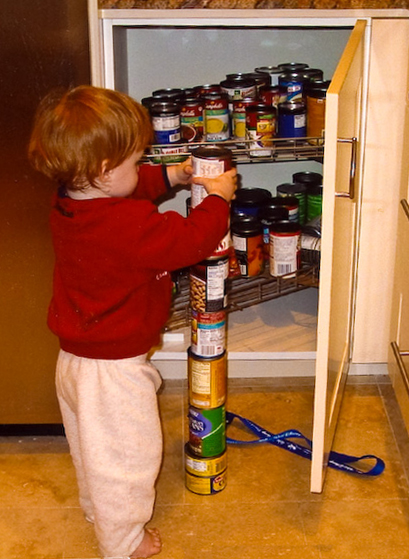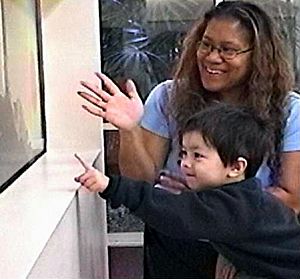Autism facts for kids
Quick facts for kids Autism spectrum |
|
|---|---|
| Synonyms | Autism, autism spectrum condition (ASC), autism spectrum disorder (ASD) |
 |
|
| Repetitively stacking or lining up objects is a common trait associated with autism. | |
| Symptoms | Difficulties in social interaction, verbal and nonverbal communication, and the presence of repetitive behavior or restricted interests |
| Complications | Social isolation, educational and employment problems, anxiety, stress, bullying, self-harm |
| Usual onset | Early childhood |
| Duration | Lifelong |
| Causes | Multi-factorial, with many uncertain factors |
| Risk factors | Family history, certain genetic conditions, having older parents, certain prescribed drugs, perinatal and neonatal health issues |
| Diagnostic method | Based on combination of clinical observation of behavior and development and comprehensive diagnostic testing completed by a team of qualified professionals (including clinical psychologists, neuropsychologists, pediatricians, and speech-language pathologists) |
| Similar conditions | Intellectual disability, anxiety, bipolar disorder, depression, Rett syndrome, attention deficit hyperactivity disorder, schizoid personality disorder, selective mutism, schizophrenia, obsessive compulsive disorder, social phobia, Einstein syndrome, PTSD, learning disorders (mainly speech disorders), social anxiety |
| Frequency |
|
The autism spectrum, autism or in the context of a professional diagnosis autism spectrum disorder (ASD) or autism spectrum condition(ASC), is a neurodevelopmental condition (or conditions). People with autism have difficulties in social interaction, verbal and nonverbal communication, demonstrate repetitive behavior and restricted interests. Other common signs include unusual responses to sensory stimuli.
Autism can manifest differently in each person. Some autistic people remain nonspeaking over the course of their lifespan, while others have relatively unimpaired spoken language. There is large variation in the level of support people require, and the same person may present differently at varying times.
While psychiatry traditionally classifies autism as a neurodevelopmental disorder, many autistic people, most autistic advocates and a rapidly increasing number of researchers see autism as part of neurodiversity, the natural diversity in human thinking, and experience, with strengths, differences, and weaknesses. On this view, promoted by the autism rights movement, autism is not pathological, but this does not preclude autistic individuals from being disabled or having high support needs.
The United States Department of Health and Human Services reported approximately 1 in 68 children are diagnosed with ASD at age 8 although onset is typically between ages 2 and 4.
Contents
Causes of autism
Scientists are still trying to determine what causes autism; it is highly heritable and believed to be mainly genetic, but there are many genes involved, and environmental factors may also be relevant. It is unclear why autism frequently co-occurs with attention deficit hyperactivity disorder, epilepsy, intellectual disability, amongst other conditions.
The combination of broader criteria and increased awareness has led to a trend of steadily increasing estimates of autism prevalence, causing a common misconception that there is an autism epidemic and perpetuating the controversial myth that it is caused by vaccines.
While autistic people remain autistic throughout their lives, various interventions can help them in different ways. Autistic people with high support needs often benefit from finding and learning other modes of communication and making their environments more accessible.
Features and characteristics
For many autistic individuals, characteristics usually first appear during infancy or childhood and generally follow a steady course without remission.
Clinicians consider assessment for ASD when a patient shows:
- regular difficulties in social interaction or communication
- restricted or repetitive behaviors (often called "stimming")
- resistance to changes or restricted interests
These features are typically assessed with the following, when appropriate:
- problems in obtaining or sustaining employment or education
- difficulties in initiating or sustaining social relationships
- connections with mental health or learning disability services
- a history of neurodevelopmental conditions (including learning disabilities and ADHD) or mental health conditions.
There are many signs associated with ASD; the presentation varies widely:
-
Common signs for autistic spectrum disorder - avoidance of eye-contact
- little or no babbling as an infant
- not showing interest in indicated objects
- delayed language skills (e.g. having a smaller vocabulary than peers or difficulty expressing themselves in words)
- reduced interest in other children or caretakers, possibly with more interest in objects
- difficulty playing reciprocal games (e.g. peek-a-boo)
- increased sensitivity or unusual response to the smell, texture, sound, taste, or appearance of things
- resistance to changes in routine
- repetitive, limited, or otherwise unusual usage of toys
- repetition of words or phrases (echolalia)
- repetitive motions or movements, including stimming
- self-harming
Atypical eating is also common, but it does not need to be present to make a diagnosis.
Some autistic people can exhibit notable ability, for example in mathematics, music or artistic reproduction, which in exceptional cases is usually referred to as savant syndrome. More generally, autistic people tend to show a 'spiky skills profile', with strong abilities in some areas contrasting with much weaker abilities in others.
Developmental course
There are two possible developmental courses of ASD. One course of development is more gradual in nature, with symptoms appearing fairly early in life and persisting. A second course of development is characterized by normal or near-normal development before onset of regression or loss of skills, which is known as regressive autism.
Social and communication skills
Autistic people experience deficits in their ability to develop, maintain, and understand relationships, as well as difficulties adjusting behavior to fit social contexts. It is common for autistic individuals to communicate strong interest in a specific topic, speaking in lesson-like monologues about their passion instead of enabling reciprocal communication with whomever they are speaking to. What may look like self-involvement or indifference toward others stems from a struggle to recognize or remember that other people have their own personalities, perspectives, and interests. Another difference in pragmatic communication skills is that autistic people may not recognize the need to control the volume of their voice in different social settings – for example, they may speak loudly in libraries or movie theaters.
Autistic people display atypical nonverbal behaviors or have difficulties with nonverbal communication. They may make infrequent eye contact – an autistic child may not make eye contact when called by name, or they may avoid making eye contact with an observer. Autistic individuals may struggle with both production and understanding of facial expressions. They often do not know how to recognize emotions from others' facial expressions, or they may not respond with the appropriate facial expressions. They may have trouble recognizing subtle expressions of emotion and identifying what various emotions mean for the conversation.
A defining feature is that autistic people have social impairments and often lack the intuition about others that many people take for granted. They struggle with understanding the context and subtext of conversational or printed situations, and have trouble forming resulting conclusions about the content. This also results in a lack of social awareness and atypical language expression.
Management
There is no cure for autism as of 2022, nor can any of the known treatments significantly reduce brain mutations caused by autism. Several interventions can help children with autism, and no single treatment is best, with treatment typically tailored to the child's needs.
The main goals of treatment are to lessen associated deficits and family distress, and to increase quality of life and functional independence. In general, higher IQs are correlated with greater responsiveness to treatment and improved treatment outcomes. Behavioral, psychological, education, and/or skill-building interventions may be used to assist autistic people to learn life skills necessary for living independently, as well as other social, communication, and language skills. Therapy also aims to reduce challenging behaviors and build upon strengths.
Intensive, sustained special education programs and behavior therapy early in life can help children acquire self-care, language, and job skills. While medications have not been found to help with core symptoms, they may be used for associated symptoms, such as irritability, inattention, or repetitive behavior patterns.
Education
Educational interventions often used include applied behavior analysis (ABA), developmental models, structured teaching, speech and language therapy and social skills therapy. Among these approaches, interventions either treat autistic features comprehensively, or focalize treatment on a specific area of deficit.
Employment
In the United States, about half of people in their 20s with autism are unemployed, and one third of those with graduate degrees may be unemployed. As of 2021, the potential for new autism employment initiatives by major employers in the United States continue to grow. The most high-profile autism initiative in the United States, "Autism at Work" grew to 20 of the largest companies in the United States. However, special hiring programs remain largely limited to entry-level technology positions, such as software testing, and exclude those who have talents outside of technology. An alternative approach is systemic neurodiversity inclusion. Developing organizational systems with enough flexibility and fairness to include autistic employees improves the work experience of all employees.
Society and culture
An autistic culture has emerged, accompanied by the autistic rights and neurodiversity movements who argue autism should be accepted as a difference to be accommodated instead of cured, although a minority of autistic individuals do continue seeking a cure. Worldwide, events related to autism include World Autism Awareness Day, Autism Sunday, Autistic Pride Day, Autreat, and others. Social-science scholars study those with autism in hopes to learn more about "autism as a culture, transcultural comparisons ... and research on social movements." Many autistic individuals have been successful in their fields.
Broader autism phenotype
The broader autism phenotype (BAP) describes individuals who may not have ASD but do have autistic traits, such as avoiding eye contact and stimming.
See also
 In Spanish: Trastornos del espectro autista para niños
In Spanish: Trastornos del espectro autista para niños
- Autism spectrum disorders in the media
- Extraordinary Attorney Woo
- List of films about autism
- Social narrative




